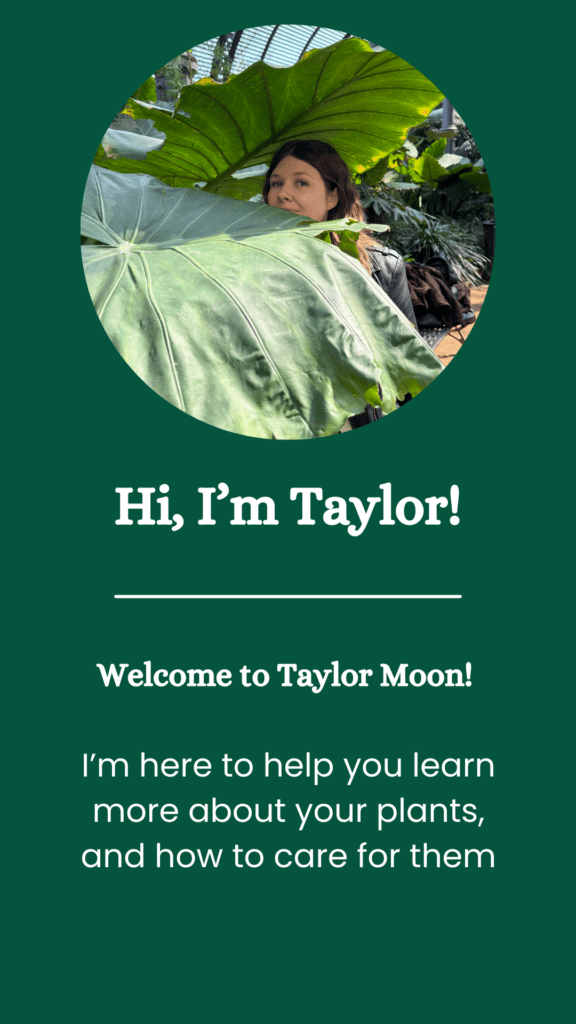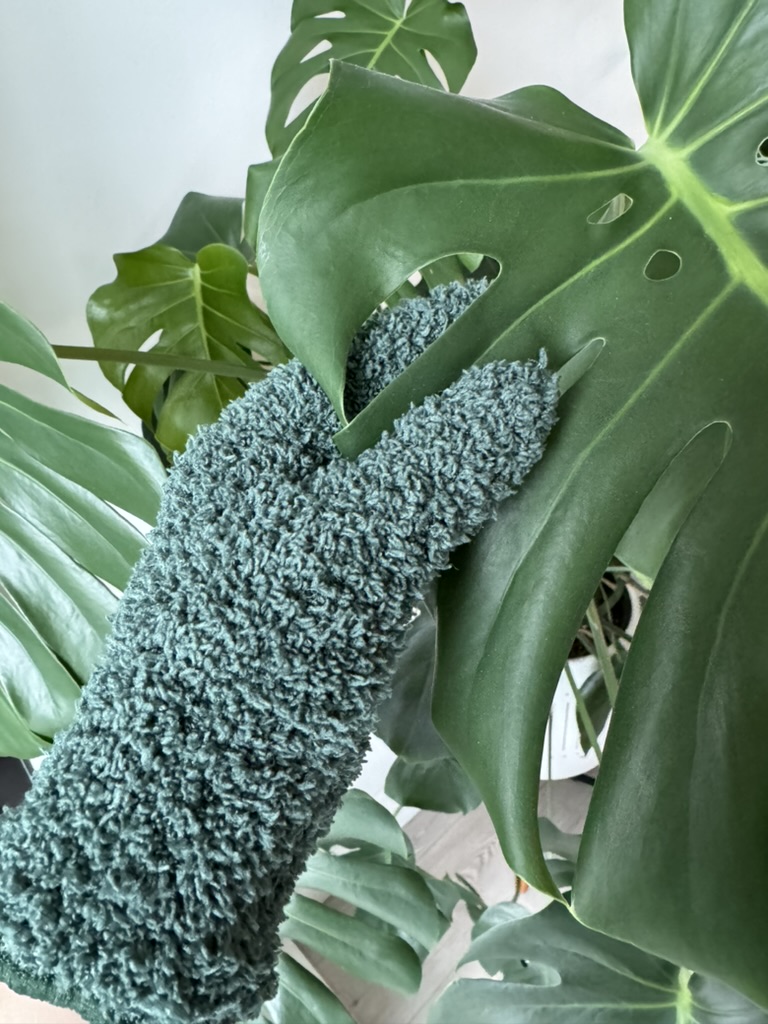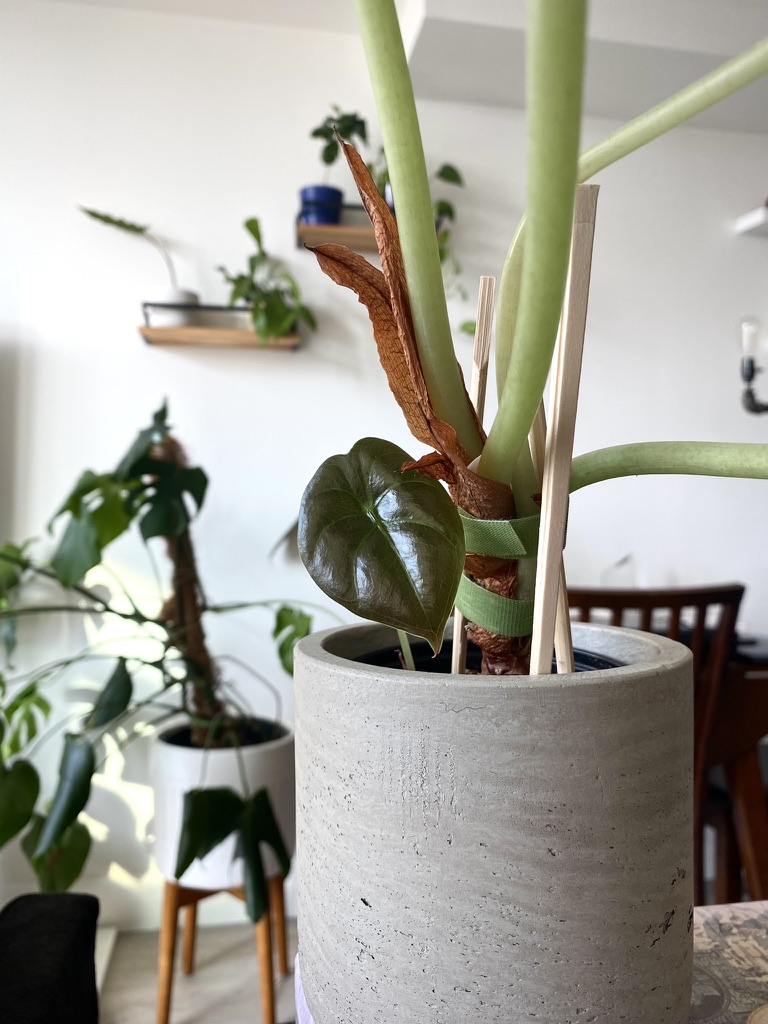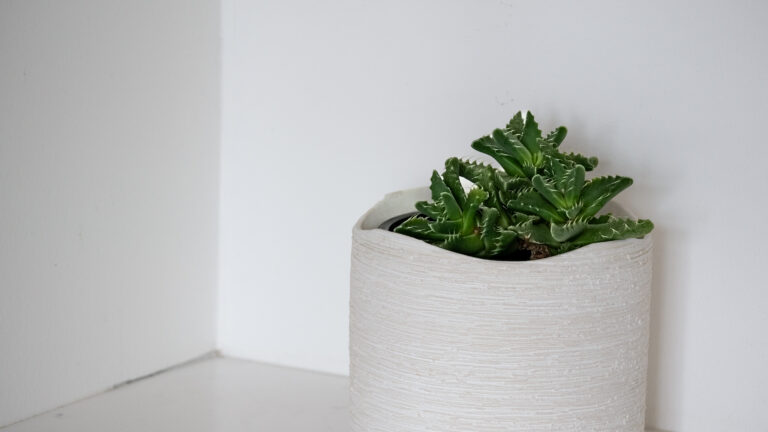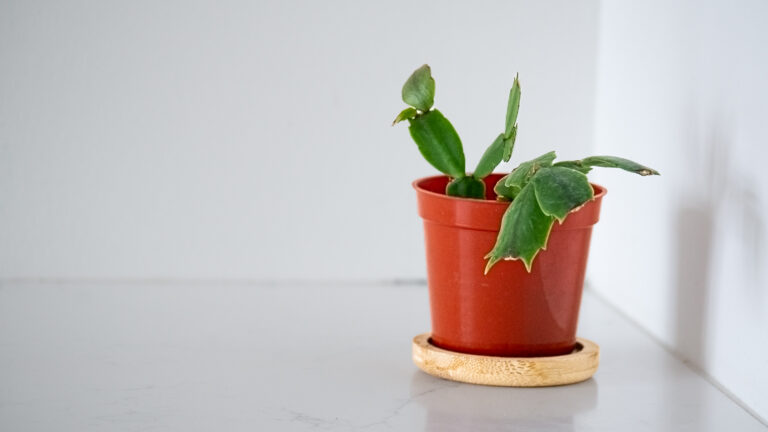Rubber Plant or Ficus elastica is a member of the Moraceae family, and Ficus genus. It is native to Southeast Asia and parts of South Asia.
Ficus elastica is referred to as the Rubber Plant because its sap used to be used for latex rubber.
There are around 1100 species of the Moraceae family, and 850 species in the Ficus genus.
🪴 Appearance of Rubber Plant
The Rubber Plant, sometimes referred to as Rubber Tree is in fact a type of tree. As it grows taller, you will see the bark start to form on the stem of the plant
The leaves of the Rubber Plant are dark green, almost black in certain lights, and glossy. New leaves grow out of the stem and appear red until they unravel to an almost golden colour, while darkening over time.
What Light Does Rubber Plant Need?
Rubber Plant thrives in indirect, medium light. They prefer indirect light for the majority of the day. With brighter light, the Rubber Plant grows faster.
I previously had my Rubber Plant in the middle of a southwest facing window, but it did much better when I moved it about 6ft from the window.
What Temperature and Humidity does Ficus Elastica Like?
Rubber Plant prefers a temperature between 18-30 degrees celsius.
They are happy with average household humidity levels (40-60%). I set my household humidity levels with the Levoit Hybrid Ultrasonic Humidifier (LV600HH).
Since I live in Canada and the winters can be very dry, the humidity can drop below 30%, so its helpful to set the humidity at about 45% or 50% in this season to keep all of my plants healthy.
How Does the Rubber Plant Grow?
On average, Rubber Plant can grow up to 10 feet indoors. In the wild, this plant can grow up to 30 ft!
New foliage grows from a red petiole, and slowly unravels revealing a golden green colour. As the new foliage grows in, it will change to a darker green.
Does the Rubber Plant Bloom?
The Rubber Tree can bloom. It can produce flowers and small fruits as it is a member of the Fig family.
How to Propagate Rubber Plant?
The easiest way to start a new Rubber Plant is by division, but the most popular way would be stem cuttings.
Division
Sometimes multiple plants will be potted together. In this situations, you can remove the entire plant from the pot, gently separate the plants, and plant the individual plants into new pots. Make sure you water the newly divided plants and place them in a bright location with indirect light.
Stem Cuttings
Before starting, you will want to protect both your hands and your work surface from the sticky, white sap that oozes from the Rubber Tree. You can do this by using gardening gloves and a potting mat. The sap can irritate your skin.
Next you will identify where you would like to cut. You will need an area that is at least 6 inches long, with at least 4 leaf nodes. An area that is leggy (elongated stems or branches) can make a great option for cuttings.
Take your shears and make a straight cut inbetween nodes. Just above the lower node and one inch below the other node. You can pat any dripping sap with a paper towel.
Once the sap stops dripping, remove the bottom leaves from each stem. You will need at least one leaf at the top of the cuttings. After you make the cutting, proceed with either soil propagation or water propagation.
Water Propagation
Place the cutting in water, ensuring the nodes are submerged.
Make sure you change out the water regularly otherwise your cutting may rot and the plant won’t root. If the water starts to get murky, change out the water and put the plant back in.
I like water propagation because I can see when the roots start to form in a clear glass container. When the roots are stable enough, I then plant it in soil.
Soil propagation
With soil propagation, you can take a cutting and put it directly in soil. If you use rooting hormone, make sure you add this to the cut end before submerging it in soil. The top node should sit on the surface of the soil mix.
You can support the cutting with a small stake.
Your cutting will do best if it is in a greenhouse-like environment. If your environment isn’t humid enough, you can simulate this by placing the potted cutting into a zip-top bag in a warm location that receives dappled sun. Spritz the cutting as needed and ensure the soil doesn’t dry out.
It can take up to five weeks to see if the cutting established roots.
Patience is key with propagation. Give your new Rubber Plant time to settle into its environment. Once you see new growth, you know your plant is well established.
How Much Water Does the Rubber Plant Need?
The Rubber Plant likes to dry out between waterings (roughly 1-2 weeks).
To determine if your plant needs water, you can stick your finger in the soil (1 to 2 inches) and if it is dry, its ready for water! If you don’t want to get your hands dirty, you can try a moisture meter.
I used to bottom water my Rubber Plant through the drainage hole of the pot on a tray when it was smaller. This is the easiest way to know if your plant is thirsty or not, and overwatering can lead to fungus gnats, root rot, or the death of your plant.
I now top water, but it’s best to do so in a pot with drainage until water is flowing out of the hole. If your pot doesn’t have drainage, you might accidentally overwater your plant.
Pests & Problems
Rubber Plant can face the following pests and problems.
Pests
Scale
Scale are small, brownish, round or oval insects that attach themselves to the leaves or stems of the plant. They are hard to notice as they appear like a growth or bump on the Rubber Plant. Scale can cause yellowing, wilting, and weakened growth. Removing scale from any plant is tedious. You can remove scale by manually removing them with a cotton swab dipped with rubbing alcohol, using insecticidal soap or neem oil.
Aphids
Aphids are small, insects that cluster under leaves and stems of the Rubber Plant. They can appear white, brown, black, gray, light green or yellow. If you see distortion, wilting or yellowing leaves, this can be a sign of aphids. You should be able to spray them off with a strong stream of water or using insecticidal soap.
Spider Mites
If spider mites have taken to your Rubber Plant, spray them with a mixture of neem oil, dish soap and water (or you can buy an insecticidal soap). I repeat this about once or twice a week (depending on the severity of infestation) for about a month. It’s also good to do this preventatively once a month or so. You will know you have spider mites if you see webbing and leaf damage. Learn how to eradicate Spider Mites.
Thrips
These are little, dark bugs that look like dirt. They suck the life out of the leaves, and lay eggs within the tissue of the leaf of the Rubber Tree. As they age, they can grow wings and infect other plants. I spray the Rubber Plant with a mixture of neem oil, dish soap and water. I repeat this every few days to try and get both the pest and the eggs. Sometimes I just chop the affected leaf since they are hard to eradicate. Complete guide on how to get rid of thrips.
Fungus Gnats
Spray the Rubber Plant with a mixture of neem oil, dish soap and water. I also let the soil dry out and add dryer sheets on top of the soil so the gnats can’t sense the moisture on the soil.
Other Common Problems
- Overwatering (root rot or leaf drop): Root rot happens from overwatering your Rubber Tree with insufficient drainage. You can improve the drainage of your plant by ensuring your plant is potted in a planter with a drainage hole and using a well draining soil (something with a decent amount of perlite). You can also end up with leaf drop, fungus gnats or fungal disease from overwatering.
- Underwatering (shrivelled or curling leaves): Even though Rubber Plants prefer to be underwatered over overwatered, you still have to remember to water it on a consistent schedule. Signs of underwatering an include leaves becoming shrivelled or curling inwards.
- Drooping Leaves: Your Rubber Tree is likely thirsty. Just give it a little water and it should be as good as new.
- Yellowing Leaves: If you have a new leaf coming in, your Rubber Plant is likely fine. Plants pull energy from older leaves to support new growth. But it can also indicate over- or under- watering or lighting issues.
- Etiolated: Being etiolated (or leggy) happens if the Rubber Tree doesn’t get enough sun. The stems will grow really long trying to reach the sun. You can fix this for future growth by moving your plant closer to the sun.
Are Rubber Plant Toxic?
The Rubber Plant is toxic to humans and pets if ingested. The sap can also cause irritation to skin. Exercise caution when the sap is involved with this plant.
Rubber Plant Quick Care Guide
| Scientific Name | Ficus elastica |
| Nickname | Rubber Plant, Rubber Tree |
| Origins | Southeast Asia and parts of South Asia |
| Light | Indirect, medium-light |
| Temperature | 18-30 degrees celsius degrees celsius (preferred) |
| Humidity | Average humidity (40-60%) |
| Height | Up to 10 feet indoors |
| Blooms | Yes |
| Propagate | Division or Stem Cuttings |
| Water Frequency | When mostly dry (likely every two weeks) |
| Pests | Aphids, Scale, Spider Mites, Thrips, Fungus Gnats |
| Common Problems | Overwatering (root rot), underwatering (leaf drop), yellowing leaves, fungal disease, etiolated |
| Toxicity | Moderate (not safe when ingested) |
References
Below is a list of external sources I consulted while writing this post. This post is a mixture of my own experiences, and the external sources listed below:
Jomo Studio – Rubber Plant
Science Direct – Moraceae
Wikipedia – Ficus
The Sill – Rubber Tree
Gardening Know How – Rubber Plant Blooms & Rubber Plant Pests
The Spruce – Rubber Tree Propagation
